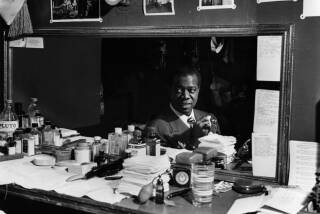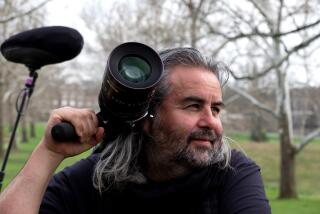JAZZ PORTRAIT ‘ORNETTE’ 20 YEARS IN THE MAKING
- Share via
“I wasn’t trying to make a ‘documentary’ of Ornette Coleman,” said director Shirley Clarke in her room at the Chateau Marmont. “I hope nobody goes to this film expecting a record of Ornette’s musical life because that’s not what it is.
“We wanted people to come away feeling a certain way about somebody and knowing a little bit about his music and its relation to him. Ornette is not violently well known (outside the jazz world) and that had something to do with my choosing to make a film that could appeal to people who just want to see this kind of film making and don’t have to know it’s about Ornette.”
Clarke’s ground-breaking portrait of the celebrated saxophonist/composer, “Ornette: Made in America” (at the Fox International through Monday), would qualify as unusual even if it was a straight documentary. It took the veteran, New York-based director 20 years to complete the film.
Clarke was a dancer who studied with Martha Graham before she moved out of performing and into the movie world in the late ‘50s. She became well known in independent film circles in the early ‘60s for her films “The Connection” and “The Cool World” before directing a 1964 documentary on poet Robert Frost that won an Academy Award.
She met the saxophonist through a mutual friend, Yoko Ono, during a mid-’60s Parisian sojourn. When an independent New York producer approached Clarke to do a movie about jazz, she embarked on a film centered around Coleman’s decision to use his 11-year-old son Denardo as the drummer for his group.
But the original project foundered in 1969 when the producer disliked a partially completed version of the film. Clarke engineered her firing from the project to avoid being liable for $40,000 in expenses and the footage spent the next dozen years gathering dust under people’s beds.
The experience shook Clarke so much that she abandoned films for the fledgling video field. Video techniques played a central role in assembling and completing “Ornette: Made in America.”
“Video allows for an emotional response on the part of the person editing,” Clarke said. “What’s going to change is that you’re going to have the same kind of freedom that actors have on stage, yet you can record it. It allows the film maker to stay in the creative process longer.”
The film project was resurrected in 1983 when the Caravan of Dreams Performing Arts Center in Fort Worth, Tex., opened its doors by engineering Coleman’s first hometown appearance in 25 years. Producer Kathelin Hoffman formed a production company to capture the event and Coleman suggested that Clarke be contacted.
The core of “Ornette: Made in America” is a nightclub set by Coleman’s Prime Time band, a performance of his “Skies of America” symphony combining Prime Time with the Fort Worth Symphony and scripted segments dramatizing some early childhood memories there. The film captures much of the improvisational flavor and unorthodox structure of Coleman’s singular musical style.
“I knew I was connecting to the way he sounded because the first thing I laid down was the sound,” Clarke said. “Then I decided what images were going to go with that particular sound. I shot every single piece we used without knowing what I was going to do with it.
“Having laid the spine down, which was his music, I edited to the music. That’s where the rhythms and energy came from. The film looks like how Ornette sounds and has the same basic thinking.”
Clarke’s use of rapid-fire editing, the juxtaposition of images and its non-linear story line gives the film a far more sweeping scope than a standard portrait of an artist. She now views the 16-year delay in completing “Ornette: Made in America” as a blessing.
“Had I finished the film at the original time, it would not have been a particularly wonderful film and probably a disaster. The fact that we had those extra years, that technology changed and the Caravan of Dreams people entered our lives, allowed a totally different thing to happen. I think it’s advanced the technology of film making by a big bang.”
Show times for “Ornette: Made in America” at the Fox International are: today through Friday and Monday, 5:30 p.m., Saturday, 2 p.m. and Sunday, 4 p.m.
‘I laid down the sound. Then I decided what images were going to go with that particular sound. I shot every piece without knowing what I was going to do with it.’
More to Read
Only good movies
Get the Indie Focus newsletter, Mark Olsen's weekly guide to the world of cinema.
You may occasionally receive promotional content from the Los Angeles Times.










